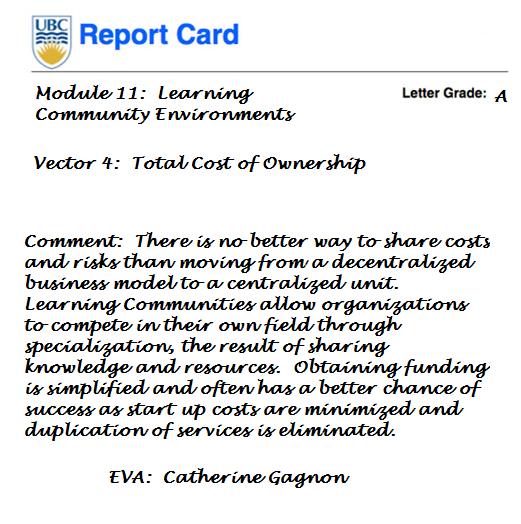Course:ETEC522/2010ST1/LearningCommunityEnvironments/Vector 4-Total Cost of Ownership (TCO)
Vector 4: The Total Cost of Ownership
This is the economic reality check. What is the full cost of an effective implementation in terms of infrastructure, training, support, depreciation, etc? Is it here to stay, or might it change drastically or disappear within a buying cycle? What does an institution need to know first?
Take a minute to view this video explanation of TCO:
Prescribed Learning Outcomes
By the end of this vector, ETEC522 participants should be able to:
- decide whether staying competitive is best accomplished through specialization or by adding services by joining a consortium;
- measure cost savings against cost of ownership.
Competitive Advantage
As different organizations in a same market try to gain a competitive advantage by offering different services, the cost of supporting these offerings is ever-increasing. In a market such as ours, where rationalization and cost cutting must drive the financial agenda of most organizations (i.e. tuition fees cannot simply continue to increase to offer better and better courses), it is necessary to find alternate competitive strategies. A consortium offers multiple advantages including cost savings and the possibility of increased market share.
"A consortium must dedicate itself to negotiating how funding can be shared among organizations with competing goals, such as school districts and online programs. This concern for interjurisdictional cooperation differs from traditional education where most school districts have little "competition" due to long term residency of students within local jurisdictions and therefore little incentive to collaborate. The lack of trust between jurisdictions must be balanced against the benefits of a consortium where closer cooperation has the potential to reduce competition, operating costs and may contribute to growing the market for online education." (Muirhead)
Furthermore, a consortium may offer organizations an opportunity to "speak with one voice" when securing funding from provincial bodies. In a recent throne speech, the Ontario Government announced that it was increasing funding to post secondary institutions, this in spite of a floundering economy. Unlike BC post-secondary institutions, universities in Ontario do not facilitate the transfer of credits from one school to another. Students are faced with having to restart whole degrees to complete them if they move from one school to another. The online programs are also inflexible in terms of completing a degree fully online or taking courses from several different institutions to finish one program. Not only does this represent a loss of income to Ontario’s post-secondary institutions (many students will complete degrees offered by such well-respected online universities as Athabasca in Alberta), but a terrible mismanagement of resources occurs in the duplication of courses, staff and infrastructure to maintain these programs. The Government of Ontario wants to establish a consortium of universities to address this growing "bleeding-out" of potential income. In the long run, this also helps ensure that great minds study and stay in the province, thus fully exploiting their contribution to the province's economy and sustaining a competitive advantage.
- You can read more about the Ontario Online Institute at Tony Bates' Blog. http://www.tonybates.ca/2010/07/13/research-for-the-new-and-undefined-ontario-online-institute/. It offers an excellent view into the formation of a consortium.
Reducing Costs

Other costs savings can be realized by facilitating sharing ideas, course content and trading anecdotes of teaching experiences (creating a community of learning) for online teachers who often work in isolation. The creation of what amounts to a "virtual staffroom" reduces costs to teachers by eliminating the need to commute to the school, resulting in a cost saving to the employer "in terms of increased productivity, flex hours, less downtime, hiring on a contract basis so only paid based on assignments handed in - these are all benefits of online learning, not necessarily of a consortium, but the consortium helps to support online learning." (Muirhead)
The major costs of online learning are supporting a huge technological infrastructure which must be constantly updated. No less negligible is the cost of keeping staff trained, up to date and engaged in this environment.
"Through cooperative purchasing arrangements online programs could address the ongoing necessity of providing both a rich technological environment and constant professional development for teachers. Joint planning for professional development can reduce costs. Bulk purchasing of computer equipment may reduce the cost of individual computers. Additionally, network costs such as Internet connectivity, toll free numbers, and multiple phone lines at a central school office and in home offices could be cooperatively tendered. Finally, the economies of scale for purchasing application software and the resulting lower costs for online course delivery software (Lotus Notes, Learning Space, and WebCT) are two immediate economic benefits of a provincial online consortium." (Muirhead)
Opportunity Costs
What will be less costly? Embarking on a new venture or staying the chosen course with constant upgrades to existing resources? This is the classic question in evaluating Opportunity Cost. We've considered Competitive Advantage, the lack of which cannot be ignored as a real cost in terms of potential lost income. Now let’s weigh other benefits of consortia against their potential costs.
Library consortia have been growing in number for similar reasons that learning institutions have found appealing.
"Consortium delivery may provide lower cost and higher quality access to scholarly information than journal subscriptions and commercial document delivery services, although the cooperative nature of a consortium may lead to bureaucratic problems of finance and implementation”. “..., a complete economic analysis requires modeling not only the financial costs and benefits to the libraries within the consortium but also the costs and benefits to library patrons of consortium services. Providing access to journal articles via a consortium service instead of subscribing to a journal requires patrons to wait for access. This time spent waiting has an opportunity cost to patrons which should be measured and incorporated into any economic analysis of consortium delivery.” (Kingma, 1997)
The Cost of Access vs. The Cost of Ownership
Calculating the cost of access to library patrons (having certain resources on hand, the patron having to physically go to the library to get the resource, hopefully when needed) begins to show us possible savings in having a large inventory available in an easily accessible, central location.
“The first source of potential savings from consortium delivery comes from the lower cost of access via consortium delivery than from other sources of delivery or purchasing a journal subscription. This source of savings only occurs if consortium delivery is the lowest cost method of access.”
Additional savings can result in reducing duplication of inventory, thus allowing for a more extensive selection and hopefully, increased use of the service as a whole (higher revenues).
“The second potential source of savings from consortium delivery comes from joint collection development by consortium members. There are many journal titles for which patron use is too low to justify a subscription at an individual library. However, many of these titles might generate sufficient use among all the libraries within the consortium to justify the consortium purchasing a subscription. In this case, one library within the consortium might purchase a subscription, perhaps financed by a subsidy from other libraries within the consortium, and provide access to patrons at other member libraries." (Kingma, 1997)
These 2 principles can be translated into other settings. For instance, a consortium of universities would realize savings in being able to deliver courses to their local community but also to a wide area, thus increasing the amount of registrations and revenue generation. Secondly, each college would be able to offer a larger catalog of courses based on the shared ownership of a great number of resources, some of which would not be able to be sustained by low demand.
"The break-even point of consortium delivery is the level of cumulative expected lifetime use by the members of the consortium such that consortium ownership and delivery costs are less than the alternative method of delivery." (Kingma, 1997)
A distinction is to be made between the cost of access and the cost of ownership. Is a student willing to pay more to be able to sign up for a course that is more in keeping with his educational goals, that may only be available online (as opposed to sitting in a classroom)? Compare this to making available as many courses as are cost effective through in-house design (the cost of creating and maintaining an inventory). Is the student willing to pay more for a brand name course as opposed to one that is available through the consortium? The cost of ownership is made up of owning the infrastructure to run the courses (online or f2f), the course development costs, staffing on-site educators and support staff - in other words, all the costs associated with a decentralized organizational model. So this is the central question then - is it more cost effective and beneficial to the organization and the clients to use a centralized system based on resource and infrastructure sharing and transparency or is it preferable to retain the status and independence of knowledge ownership?
The Connecticut Distance Learning Consortium - An Illustration

The CTDLC was formed in the late 1990s to provide consortial IT services to 36 member institutions.
It provided:
- IT services including a Web site,
- marketing online courses and programs for all members,
- course management software,
- course hosting,
- course development, faculty training,
- help desk support for students and faculty,
- online student assessment,
- a student financial aid database, and more.
Revenue sources:
- $2.5 million dollar budget from the legislature,
- additional revenue from fees and services.
"The Connecticut
General Assembly wanted to build such an infrastructure once and let all of higher education share it as needed. While no one was forced to use the CTDLC infrastructure, the legislature refused to fund any requests for individual infrastructure from different
schools."
The resulting plan means that "36 IT departments don’t have to find the resources to address distance learning. This approach had no trouble winning funding from the Connecticut legislature because it meant that higher education was working to avoid duplication of services — one of the legislature’s criticisms of our industry."
The online database, created from joint marketing efforts, resulted in market specific data being available to member institutions. The community effort lead to the Connecticut General Assembly funding the CTDLC an additional $150,000 per year for marketing.
"This approach can share
costs across budgets, thereby reducing the start-up price for any single institution, empowering wide-ranging experimentation by multiple schools, and concentrating specialized IT skills
in a single place."
The first services that CTDLC offered were faculty training and courseware production.
The startup budget:
- $30,000 in Sloan Foundation money,
- 30,000 from our community colleges,
- and human resources from Charter Oak State College.
From which they:
- bought,installed, and operated a course delivery system;
- hired a server hosting company;
- bought hardware (one server) and
- a license ($15,000)
"In year two our legislature created our first budget of $200,000. This grew to $523,000 in the next year and then $2.5 million in fiscal year 2001."
Two major advantages of consortial IT are 1.the ability to fundraise as a group and 2. the opportunity for members to use those services at virtually no cost to them, freeing them to create learning programs without fear of large capital expenditures for infrastructure and the risk of poor decisions with regards to technology.
"Since all schools must approach their
legislatures for money, often for projects that seem redundant, asking for common dollars to support a common infrastructure appealed to Connecticut’s
General Assembly."
"The challenges involve funding,
personnel, and attitude. We solved the funding problem in two ways: first, the CTDLC has successfully lobbied the legislature for resources, and second, we’re recovering about 50 percent of our costs through the fees we charge for services to our members and our corporate clients. So our financial model combines legislative
support and growing self-sufficiency."
(Adapted from Consortial IT Services: Collaborating to Reduce the Pain, 2001)
Glossary of terms:
- Competitive Advantage: Something that gives a firm (or a person or a country) an edge over its rivals.
- Opportunity cost: The true cost of something is what you give up to get it. This includes not only the money spent in buying (or doing) the something, but also the economic benefits (utility) that you did without because you bought (or did) that particular something and thus can no longer buy (or do) something else.
- Economies of scale: Bigger is better. In many industries, as output increases, the average cost of each unit produced falls.
- Cost vs benefit analysis: A method of reaching economic decisions by comparing the costs of doing something with its benefits.
- Break-even point: Point in time (or in number of units sold) when forecasted revenue exactly equals the estimated total costs; where loss ends and profit begins to accumulate. This is the point at which a business, product, or project becomes financially viable.
- Rationalization: Selling off or closing down some plants or units to reorganize a firm's operations to be more in line with its core competencies, in the interest of efficiency, or as a cost cutting measure.
- Transparency: A buzz word for the idea that the more information is disclosed about an economic activity the better.
Taking up the question from the 2nd video in Vector 1: “How do we earn a living when everyone is sharing?” Perhaps the question should be rethought to reflect the competitive environments of globalization and social networking. Can we continue to compete if we don't share knowledge? The question is central to many other emerging markets. A study of the advantages of Open Source Software clearly reveals that the age of proprietary software is waning. There are simply more benefits to sharing information than there are to placing time and money into differentiating knowledge.
Discussion
Case Study: in Ottawa, we used to have a media centre run by the Ottawa District School Board that both public and Catholic board used. A few years ago, the provincial government cut funding and the centre was closed. Now our schools have to supply themselves with multimedia resources and our school libraries try to take up the slack with their meagre budgets.
Compare the cost of access to the cost of ownership when considering if a consortium would be the solution to this problem. Place your comments on our course blog.
Vector Report Card:
References:
Bates, T. (2010, March 30). Online learning in Ontario « Tony Bates. Tony Bates. Retrieved July 11, 2010, from http://www.tonybates.ca/2010/03/30/online-learning-in-ontario/
Kingma, B. R. (1997, Winter). Interlibrary loan and resource sharing: the economics of the SUNY Express consortium - University libraries of the State University of New York at Albany, Binghamton, Buffalo, and Stony Brook; Resource Sharing in a Changing Environment | Library Trends | . Find Articles at BNET | News Articles, Magazine Back Issues & Reference Articles on All Topics. Retrieved July 9, 2010, from http://findarticles.com/p/articles/mi_m1387/is_n3_v45/ai_19192270/
Klonoski, E. (2001, April 1). Consortial IT Services. Educause. Retrieved July 15, 2010, from net.educause.edu/ir/library/pdf/EQM0122.pdf
Muirhead, B. (n.d.). The Benefits of an Online Education Consortium for Alberta, 3(4). International Electronic Journal for Leadership in Learning. Retrieved July 2, 2010, from www.ucalgary.ca/iejll/muirhead
Glossary of Terms was produced using:
http://www.economist.com/research/economics/
http://www.businessdictionary.com/definition/
Return to Vector 3: Stability and Usability
Continue to Vector 5: Future Potential
Return to Course:ETEC522/2010ST1/LearningCommunityEnvironments
